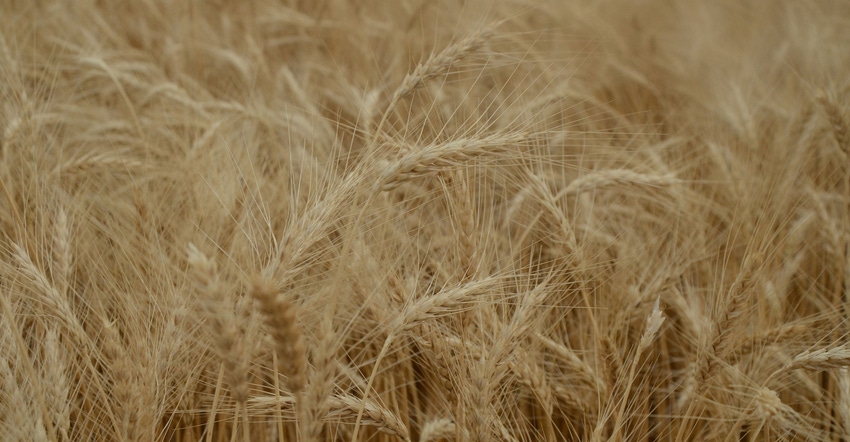
For Alec Horton of Leoti, Kan., and his two brothers, Rick and Matt, reaching 100-plus-bushel wheat has been part of a carefully calculated equation.
This year, they harvested 95.3-bushel-per-acre hard red winter wheat as part of the National Wheat Yield Contest using WestBred's Grainfield. While this yield won first place for the dryland winter wheat category for the state of Kansas, Alec Horton notes several factors led to lower yields compared to last year.
Last year, they won the contest for the dryland winter wheat category for the western region of Kansas at 121.48 bushels per acre using Joe, a Kansas Wheat Alliance hard white wheat variety. Meanwhile, one of their Grainfield plots yielded over 105 bushels.
One reason for lower yields this year was heavy spring snowfall in western Kansas.
"In April when we had 2½ to 3 feet of snow, we were at the boot stage on some of our wheat, and three to four days away from the boot stage on everything else," says Horton, noting that the snow covered the ground for three or four days, kinking wheat stems, and limiting moisture and nutrient use by the plants. "The snow definitely limited us on our yield this last year. We were expecting to hit the 120-bushel range again until we got the snow."
Still, 95-bushel winter wheat is no small feat. And a big factor for Horton is seeding rate. While the traditional mindset is to plant based on pounds per acre, he and his brothers plant wheat based on seeds per acre. That's because every variety has a different seed size — not to mention a different head size, standability and number of tillers. Over the last three years, they've been fine-tuning the seeding rate for the Grainfield variety.
"With Grainfield, we need to average about 56 to 62 final heads per square foot in the field. Then as long as we can manage our populations, we let Mother Nature decide how big it's going to let that head be. Most of the time those two equal out to an 80- to 120-bushel yield goal depending on our moisture, climate and different things," Horton says. "That puts us at 525,000 seeds per acre. We've gone to actual seeds per acre instead of pounds, because seed size varies so much. It was equal to about 39 pounds per acre."
Lower population, more moisture
By cutting back on populations, the Hortons are also hoping to conserve moisture and prevent lodging.
Their experience with planting based on seeds per acre started with TAM 112 — an older hard red variety from Texas A&M University.
"It's a phenomenal variety for southwest Kansas with excellent drought tolerance, but it fell down if stands got too thick," Horton says. "We thought maybe we can drop our seeding rates. We might get lower yields, but we can at least get it to stand. As it happened, we increased yield by about 10%, it stood, and we dropped our seeding rate down to 45 pounds."
"You can't just go off of pounds every year," he adds. "You have to get back to population. It comes down to the farmer willing to try different seeding rates and watching the varieties and how they perform on that field. I think they'll be surprised with what these varieties can do now if you take a more corn and soybean approach to wheat rather than planting them all the same regardless of the variety."
That also means fertilizing wheat like a cash crop. The Hortons typically apply 5 tons of conditioned manure after the wheat crop is harvested, allowing manure to slowly break down and snow to move the nitrogen into the profile.
After harvesting a grain sorghum crop off the field the next year, they leave the field fallow before returning to winter wheat. Based on soil samples and tissue tests, they top-dress the wheat in late winter. This year, they applied 60 pounds of nitrogen over the top of wheat in February.
Next year, Horton says they plan to do more field testing and apply nitrogen at different times to ensure the crop has nitrogen readily available when it needs it, and so the crop can take it up before the double ridge stage — just in case spring moisture is sparse, as was the case last year in western Kansas.
"It wasn't until about late March or early April last year when we got any significant moisture to move that nitrogen we applied in February into the profile and be actively taken up," he says. "The actual head size of the wheat is determined at double ridge stage, just prior to jointing. So at that point, you've already determined how big your head's going to be. If you've determined your factory at that point and don't have your topdress on to determine the yield factor, I think we left some yield on the table last year."
"We're going to actively take tissue samples a little earlier on in the growing season just to see what nutrients we have in the plant and compare that to our yield at the end of the season," Horton adds. "As long as we have those levels in the plant, we know we have potential to capture 120-bushel wheat."
About the Author(s)
You May Also Like




